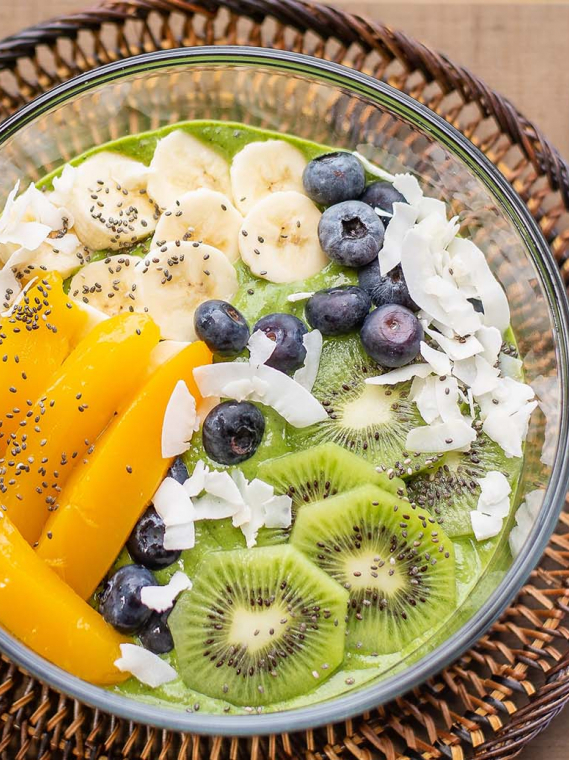
Miriam Albero's Smoothie Bowl in 5 minutes
Comida y Bebida
27 de julio de 2015
Lifestyle blogger, Orca ambassador and keen triathlete Miriam Albero brings you the perfect Smoothie Bowl recipe that can be whipped up in less than 5...
Don't allow yourself to become overwhelmed or subject to 'paralysis by analysis' when it comes to nutrition in triathlon. US Triathlete and Wellness consultant Justin Park has some simple, easy to follow rules that will help!

Orca athlete Justin Park, is a top professional triathlete and Executive Wellness Consultant who combines his athletic and business acumen to advance leading corporations’ healthcare initiatives. He has finished on the podium at some of the world’s largest races, setting several course records in the process, all while helping to found The Carolina Clinic at UNC, an executive wellness program and division of UNC Hospitals. So he knows a thing or two about nutrition! Here are some of his personal nutrition 'rules' he's developed over the years as a triathlete.
Through my racing, consulting and speaking, the topic that I get asked about most, without question, is nutrition. People want to know what they should eat, when to eat, what to avoid, and how much to consume. Even those inquisitive individuals who do their own research and investigation become confused by all of the discussion that exists in regards to diet. Indeed, the further you dig, the more you may be subject to paralysis by analysis.
The fact is, while there is an amazing amount of valuable and informative information available, there remains a lot that we simply don’t know about nutrition. What works for some people doesn’t work for others, and it is incredibly (if not impossibly) difficult to standardize all of the numerous variables that exist in dietary research studies when trying to determine the effect of one type of food or food group on the body.

So where does that leave us? Basically, it requires that you serve as your own personal research study. Experiment with many different types of food, evaluate your response to those foods over time, and slowly develop guidelines and strategies that work for you.
I have done exactly this throughout my career in triathlon and corporate wellness, and gradually my own personal “Nutrition Rules” emerged. My key principles are below, and I encourage you to review them and see how they may be applicable to you.
1. Your mom was right about breakfast. While we never wanted to listen to our parents as kids, they were not wrong when telling us that “breakfast is the most important meal of the day.” Skipping breakfast has been consistently linked to health risks in numerous studies – high blood pressure, obesity, and an unhealthy composition of blood-fats, just to name a few. But not for the reasons you may think. Most people believe that skipping breakfast leads to extra indulgence throughout the day to make up for those lost calories. However, the actual answer is likely that skipping breakfast keeps your body in a stressful state of fasting, which can disrupt metabolism and hormone function in very considerable ways. Other than sleep, at no other point in a day do we go 7-8 hours without food. Fasting is a stressful state for the body, so prolonging the fast by skipping breakfast upon waking only amplifies the stress and associated response in the body. There is a reason is it called “break fast,” after all.
2. Dark, leafy greens are your multivitamins. Many of us resort to the daily multivitamin in order to ensure that our bodies are adequately topped off with key nutrients like fiber, folic acid, iron, potassium, magnesium, calcium, and vitamins A, C and K. However, it turns out that all of these things already exist in very convenient leaves that can be grown in your own garden or picked up at the grocery store. And unlike multivitamins, greens also contain a large variety of carotenoids (such as lutein and zeaxanthin), flavonoids and other powerful antioxidants that have cancer-protective properties. As a result, I incorporate greens in every meal throughout the day, whether it be adding them to an omelet for breakfast, topping a sandwich at lunch, or building a nutritious salad with dinner. And don’t forget to take advantage of the wide variety of leafy greens. Spinach and kale get all the publicity, but arugula, mustard greens, watercress, Swiss chard, and bok choy all contain their own unique benefits and flavors.
3. A slow-cooker is your friend. The number one complaint I hear about failing to stick to a nutritious and healthful diet is lack of time. So why not adopt a kitchen appliance that resolves this issue? A slow cooker takes all of the preparation time out of the equation. It can be set in the morning before leaving your house and provide you with a delicious meal ready when you return home for the evening. In addition, because all of the ingredients stew on each other for 6-8 hours, it creates a tremendous amount of flavor from very healthy ingredients. Simply throw in a lean protein, add in nutritious vegetables like peppers, carrots, onions, mushrooms and cabbage, top off with a few spices and a “liquid” (such as salsa, BBQ sauce, or even yogurt for Greek-flavored chicken). Prepare some rice when you arrive home from work, and you have an incredibly tasty meal without any of the hassle.
4. Your body knows better than you do. This rule seems a bit abstract conceptually, but its importance is critical. Even the best of us who attempt to eat as healthfully as possible often fall short in certain areas or miss key nutrients here and there. If you take the time to listen to your body’s cues, it will often give you an indication of what it is lacking. For example, on some occasions after either particularly difficult training days or races, I absolutely crave a burger, fries and a beer. And I’m not talking about organic, grilled bison loaded with vegetables and baked sweet potato fries; I’m talking about beef covered in cheese with the greasiest fries one can imagine. If I were to stick to a rigorous diet, that option would never be a possibility. However, because that craving does not come around very often, it is a clear indication to me that my body is in dire need of saturated fat (not always the enemy it is conveyed to be in some scientific literature), sodium and calories. And every time I have listened to that cue and eaten such a meal, I have felt incredible the day after. So take the time to be present and listen to what your body needs. It will tell you.
5. Don’t be a teacher’s pet. You know that kid who sat at the front of the class in high school and answered all of the teacher’s questions? He or she wasn’t always the most fun to be around, huh? The same thing applies with diet. If you aim for perfection at all times, not only will you fail (which doesn’t always have a great impact psychologically), but truth be told, you also won’t be that much fun to be around. As long as the foundation of your diet is rooted in healthful, nutritious foods, a few splurges here and there will have little impact overall. Think of it as 85/15: if 85% of your diet consists of sound nutritional decisions, the remaining 15% can be whatever you want. Not only will that give you more flexibility to give in to your indulgences every once in a while, but your friends will be able to tolerate you a little more as well.
Remember, you are unique. And don’t worry, this isn’t the time where I start to give you a pep talk similar to Stuart Smalley’s “I’m good enough, I’m smart enough, and doggone it, people like me” from Saturday Night Live. “Unique” in this instance refers to the fact that, regardless of how many research studies, articles and experts create steadfast rules regarding nutrition, your body responds to specific foods and diets in a way that is unique to you. Therefore, it is important to experiment and not get caught up in dogma about what is good for you and what is bad for you.
Your rules of nutrition are just that…yours.

27 de julio de 2015
Lifestyle blogger, Orca ambassador and keen triathlete Miriam Albero brings you the perfect Smoothie Bowl recipe that can be whipped up in less than 5...

3 de julio de 2015
Seas o no americano, probablemente sabrás que el Día de la Independencia se celebra tradicionalmente entorno al fuego de la parrilla. Andrew Starykowi...

25 de junio de 2015
A la atleta ITU neozelandesa y embajadora de Orca, Sophie Corbidge, le encanta la repostería y es conocida por sus deliciosas creaciones. Desde Orca l...